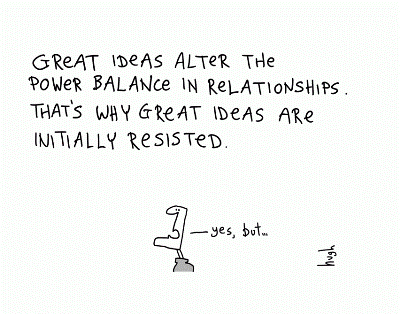While the Industrial Age was marked by increasing specialization, the “Return of the Generalist” in society is a common theme in many books. It has been recognized already in 2005 by Dan Pink in his book “A Whole New Mind: Why Right-Brainers Will Rule the Future“, and I found the issue further developed in an interesting book, “The Rise of the Naked Economy: How to Benefit from the Changing Workplace” by Ryan Coonerty and Jeremy Neuner.

In this book about the future of work and of the workplace, they identified two key players in the “Naked Economy” of the future: big-picture thinkers, who they call the Smart Generalists, and the small-bore experts, the Super Specialists. The two are complementary. In our future project-based working environment, Smart Generalists will coordinate the work of Super Specialists, and both will have tremendous value.
In the book, the author mention that “My value, like all generalists’, is to know a little about a lot. That means the onus is on me to constantly reach out to new people, read books and articles, watch the trends in a wide range of arenas, and generally be passionately interested in the world. Having that broad knowledge to draw on, and to be able to use it when I need it, brings me a lot of credibility when I’m dealing with people in business, government, or academia.”
The Smart Generalist is coming back, watch for the change in the workplace!
Related Posts:


 Further he writes, “In
Further he writes, “In 





 Real good ideas do necessarily alter the power relationships (and that is why they are always resisted, but that is another story).
Real good ideas do necessarily alter the power relationships (and that is why they are always resisted, but that is another story). It appears that there are strong regulations in the US about the fact that cars would need to be sold through franchised car-dealerships and this creates all sorts of weird market effects. Tesla is currently battling to topple these old-fashioned regulations, and might well eventually win at that game, although that will take long consistent efforts (see Bloomberg’s paper on “
It appears that there are strong regulations in the US about the fact that cars would need to be sold through franchised car-dealerships and this creates all sorts of weird market effects. Tesla is currently battling to topple these old-fashioned regulations, and might well eventually win at that game, although that will take long consistent efforts (see Bloomberg’s paper on “ One of the points of the paper is that “power structures haven’t changed much over time, […] the way organizations operate today actually reflects hundreds of years of hierarchical power structures, and remains unchanged because these structures ‘can be linked to survival advantages’ in the workplace“. Also, “hierarchies deliver practical and psychological value, in part by fulfilling deep-seated needs for order and security“.
One of the points of the paper is that “power structures haven’t changed much over time, […] the way organizations operate today actually reflects hundreds of years of hierarchical power structures, and remains unchanged because these structures ‘can be linked to survival advantages’ in the workplace“. Also, “hierarchies deliver practical and psychological value, in part by fulfilling deep-seated needs for order and security“.